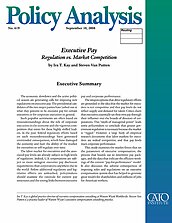The economic slowdown and the active political season are generating calls for imposing new regulations on executive pay. The presidential candidates of the two major parties have lashed out at what they perceive to be excessive pay for certain executives or for corporate executives in general.
Such populist sentiments are often based on misunderstandings about the role of corporate executives in the economy and the vigorous competition that exists for these highly skilled leaders. In the past, federal regulatory efforts based on such misunderstandings have generated unintended consequences, which have damaged the economy and hurt the ability of the market for executives to self-regulate over time.
The labor market for executives and the associated pay levels are already subject to high levels of regulation. Indeed, U.S. corporations are subject to more stringent executive pay disclosure requirements than corporations anywhere else in the world. Before additional regulatory and legislative efforts are unleashed, policymakers should examine the rationale for current pay structures and the strong links between executive pay and corporate performance.
The misperceptions that drive regulatory efforts are grounded in the idea that the market for executives is not competitive and that pay levels do not reflect supply and demand for talent. Critics claim that executives essentially set their own pay through their influence over the boards of directors of corporations. This “myth of managerial power” leads some policy makers to conclude that greater government regulation is necessary because the market is “rigged.” However, a large body of empirical research documents that labor markets for executives are indeed competitive, and that pay levels track corporate performance.
This study examines the market forces that set the parameters of executive compensation, the process that boards use to determine pay packages, and the data that indicate the efficient workings of the current “pay-for-performance” model. It also discusses the adverse consequences of imposing rules and regulations on an executive compensation system that has helped to generate great wealth for shareholders and millions of jobs for American workers.
About the Authors

This work is licensed under a Creative Commons Attribution-NonCommercial-ShareAlike 4.0 International License.
